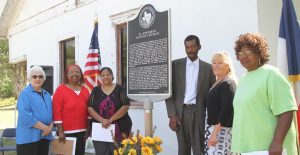One of Clarendon’s oldest churches received well-deserved recognition last Saturday, September 17, when a state historical marker was dedicated at St. Stephens Baptist Church.
A crowd of about 40 people were on hand to commemorate the founding of the Texas Panhandle’s first African American church and the pioneer spirit embodied by its earliest members.
Donley County Historical Commission member Jack Moreman gave the welcome as the Adamson-Lane Post 287 of the American Legion presented the colors and led in the pledges to the Texas and American flags. Donley County Historical Commission Chair Jean Stavenhagen then read the history of St. Stephens.

The creation of St. Stephens Baptist Church followed the pathway of first came the congregation, then came the church on its journey into history.
In 1887, the small settlement of Clarendon moved south to the newly built railroad and became known as New Clarendon. Jobs were plentiful following the rush to buy land, build homes and establish businesses. People came from all over the area to find work including black families. They found jobs on this new frontier where they built homes for themselves and settled to work.
New churches were being quickly built for the citizens of the new town and some may have been attended by the black families, but they wanted a church of their own – a place where they could worship in their own way. With the help of a legendary black cowboy named Matthew “Bones” Hooks, the people organized their church and named it St. Stephens for Rev. Sid Stephens who became their first pastor. Hooks had met Stephens on the train as he travelled to Clarendon to break horses for Charles Goodnight.
In the years that followed, the congregation gathered for worship and Sunday School in vacant shelters, unused buildings, and in their homes. The long line of pastors who followed Rev. Stephens came from surrounding towns and churches to preach at St. Stephens. But the little church struggled at times when attendance was low and money was too scarce to pay the preachers. Places to worship were sometimes hard to find. Often the women of the church baked and sold pies, cakes, cookies and sometimes barbecue to raise money which allowed the congregation to hold on their church.
In May 1918, the church building was destroyed by a massive flood. However, under the leadership of Rev. Pickford, the congregation found a new location, and in spite of declining membership, the church remained strong. In 1930, Rev. J.J. Hayden organized the first choir who sang at church services and performed for the public on special occasions.
In the 1950s, an abandoned church in Lelia Lake was donated to the St. Stephens congregation. It was moved and placed on property owned by Alfred McMurtry, a prosperous local citizen. In September of 1968, McMurtry sold two lots of the property to the trustees of St. Stephens for $10. The church had finally found a permanent home and remains on the same property today.
The congregation of St. Stephens celebrated their 103rd anniversary on September 14, 2000. It was a grand event with choirs, pastors, and members from other churches attending. Dinner was served at the Clarendon Lions Hall to a large crowd during that celebration.
“St. Stephens Baptist Church in Clarendon was the first church for black families in the Panhandle,” Stavenhagen said. “It has struggled much, but it has given much. May it continue throughout another century.”
Following special music by Jim Shadle, Stavenhagen presented certificates to Pastor Roy Williams, Beverly Alexander, Joann Brown, Doris Gardner, and Bobbie Ruth Louis for their assistance and efforts in researching the church history.
Pastor Williams also thanked the crowd and those responsible for helping secure the state marker for St. Stephens before closing the ceremony with a prayer.


Leave a Reply
You must be logged in to post a comment.